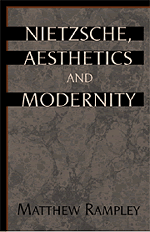Book contents
- Frontmatter
- Contents
- List of Abbreviations
- Acknowledgements
- Introduction
- 1 Truth, Interpretation and the Dialectic of Nihilism
- 2 Nietzsche's Subject: Retrieving the Repressed
- 3 Laughter and Sublimity: Reading The Birth of Tragedy
- 4 Wagner, Modernity and the Problem of Transcendence
- 5 Memory, History and Eternal Recurrence: The Aesthetics of Time
- 6 Towards a Physiological Aesthetic
- 7 Art, Truth and Woman: The Raging Discordance
- 8 Overcoming Nihilism: Art, Modernity and Beyond
- Notes
- References
- Index
6 - Towards a Physiological Aesthetic
Published online by Cambridge University Press: 18 March 2010
- Frontmatter
- Contents
- List of Abbreviations
- Acknowledgements
- Introduction
- 1 Truth, Interpretation and the Dialectic of Nihilism
- 2 Nietzsche's Subject: Retrieving the Repressed
- 3 Laughter and Sublimity: Reading The Birth of Tragedy
- 4 Wagner, Modernity and the Problem of Transcendence
- 5 Memory, History and Eternal Recurrence: The Aesthetics of Time
- 6 Towards a Physiological Aesthetic
- 7 Art, Truth and Woman: The Raging Discordance
- 8 Overcoming Nihilism: Art, Modernity and Beyond
- Notes
- References
- Index
Summary
All art works tonically, increases strength, inflames desire (i.e. the feeling of strength) excites all the more subtle recollections of intoxication.
(WP §809)Nietzsche's preoccupation with the question of time forms a central part of his critique of metaphysics and modernity, in which the modernist obsession with time and history is countered with the idea of Eternal Recurrence. The denial of time could be seen as standing at the origin of metaphysics, in Plato's valorisation of timeless Ideas, but Nietzsche's argument is that as in so many other respects, modernity constitutes both the climax of metaphysics and the moment of its unravelling. Hence the denial of temporality is joined by its dialectical negation, a morbid fascination with decay and decline, which is produced by the sense of time as a problem, and of temporality as a succession of mutually transcending ‘nows.’ The path to overcoming the temporal logic of modernity lies both in an aestheticisation of historical knowledge (though not at the expense of ‘objectivity’) and in the model offered by certain forms of artistic praxis, which embody a certain temporality both in terms of their external relation to the artistic tradition and in their internal semantic structure.
In his attention to the question of time and modernity, Nietzsche is undercutting the idea of transcendence sustaining metaphysics. The notion of transcendence, however, has both a temporal and a spatial dimension, and the concept consequently depends on extensive use of spatial and temporal metaphors for its exposition. It is apparent from the discourse of the sublime in which, as I have indicated before, Longinus's use of the metaphor of ‘transport’ becomes prominent in eighteenth-century writings on the sublime.
- Type
- Chapter
- Information
- Nietzsche, Aesthetics and Modernity , pp. 166 - 189Publisher: Cambridge University PressPrint publication year: 1999



